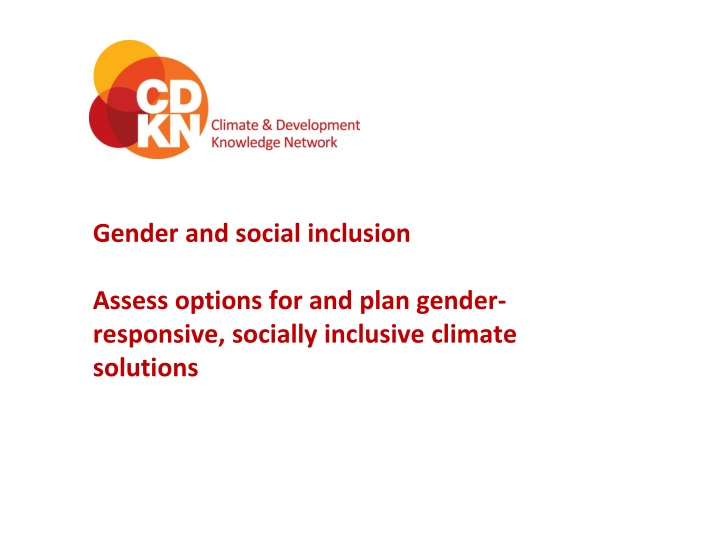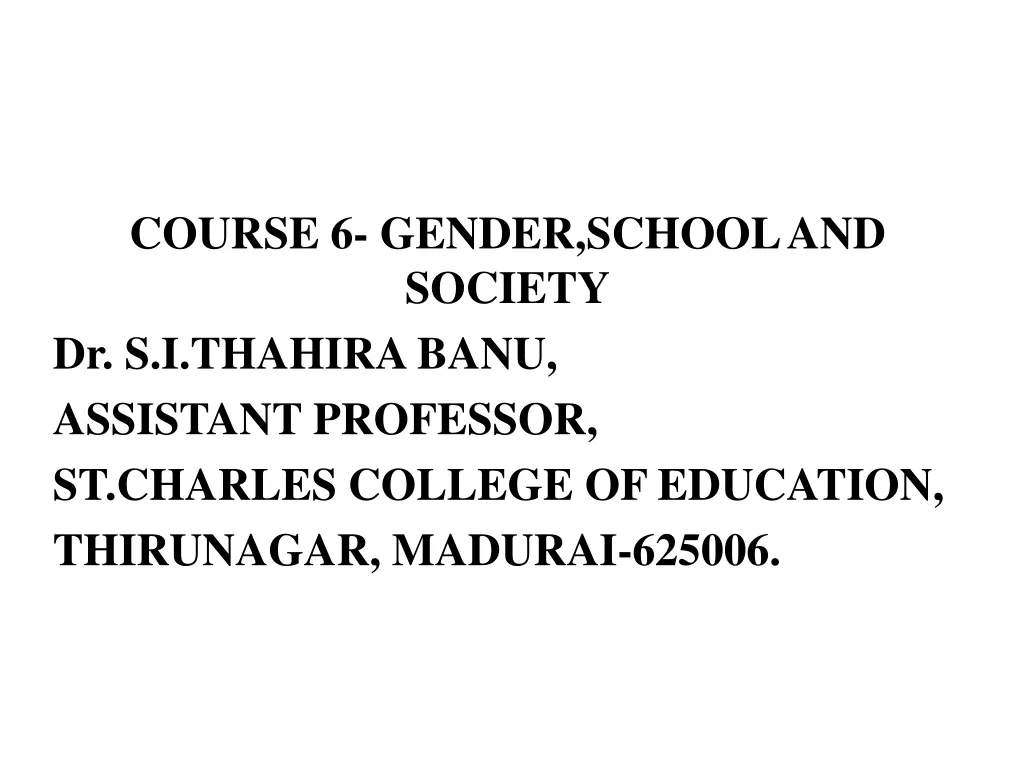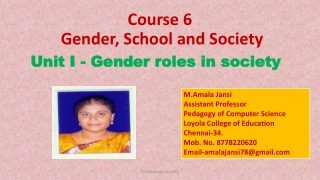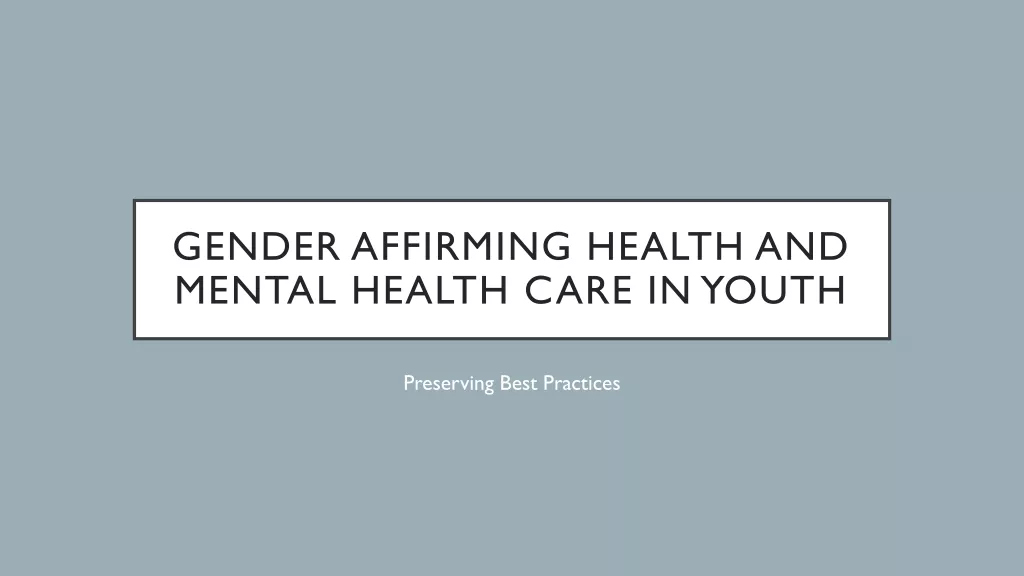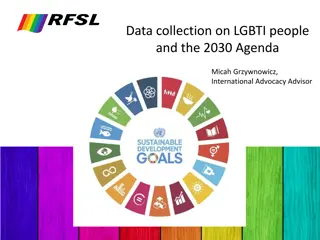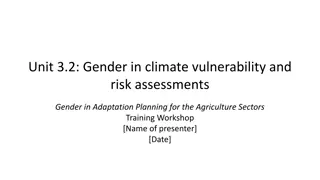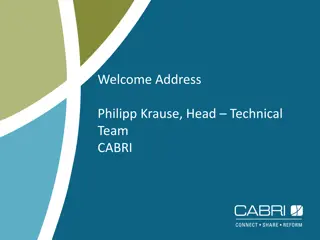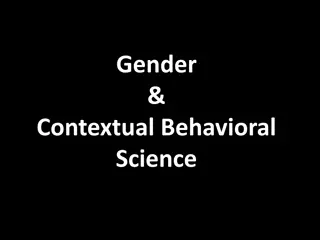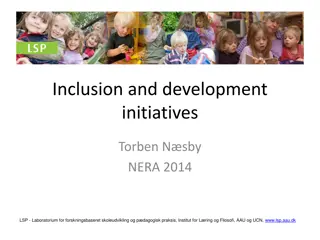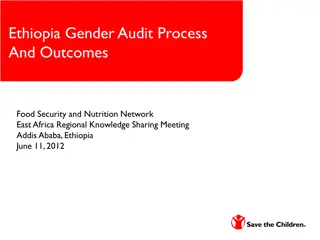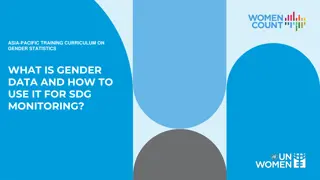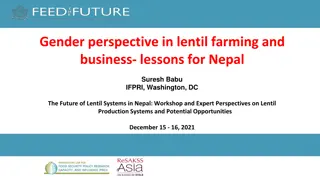Gender and Social Inclusion in Climate Solutions Assessment
Assessing vulnerabilities, needs, capacities, and risks in gender-responsive, socially inclusive climate solutions. Understanding differential impacts on women and men, establishing baselines, and identifying barriers to women's participation in low-emission development. Utilizing problem tree analysis to address gender inequality, poverty, and climate shocks in the context of a micro-finance case study in Ethiopia.
Uploaded on Oct 01, 2024 | 1 Views
Download Presentation

Please find below an Image/Link to download the presentation.
The content on the website is provided AS IS for your information and personal use only. It may not be sold, licensed, or shared on other websites without obtaining consent from the author.If you encounter any issues during the download, it is possible that the publisher has removed the file from their server.
You are allowed to download the files provided on this website for personal or commercial use, subject to the condition that they are used lawfully. All files are the property of their respective owners.
The content on the website is provided AS IS for your information and personal use only. It may not be sold, licensed, or shared on other websites without obtaining consent from the author.
E N D
Presentation Transcript
Gender and social inclusion Assess options for and plan gender- responsive, socially inclusive climate solutions
Recap: What the assessment of vulnerability, needs, capacities and risks assessment achieved (module 3) Combined qualitative and quantitative data in order to understand if, how and why women and men are affected differently within a particular context or sector. Established a baseline. Climate impacts and adaptation: The analysis should have revealed differences in how climate impacts are felt and how gender-responsive adaptation actions can be formulated in response (which will be elaborated more in this module). Low emission development : Should have highlighted barriers to women s participation in climate solutions and green economy and point to ideas on how equitable participation can be supported (which will be elaborated more in this module).
In this module you will learn How to funnel the assessment of people s climate-related development needs, risks and capacities (from the last stage/module) into an assessment of possible solutions using complementary methods. Ideas for taking the range of solutions and mapping them to a project or programme plan that will deliver improved outcomes for women and girls, and for everyone.
Next step: assess drivers of climate and development problems, and possible solutions
Problem tree method This is when you unpack the central climate change (and/or associated social-behavioural) issue your project will address and the underlying drivers and root causes of the problem and the impacts it creates. Problem tree method systematically looks at causes and consequences, helping to reveal solutions
Problem Tree Analysis: Ethiopia Micro-Finance Case Study Low community and national resilience to climate shocks Impacts Gender inequality Increased poverty Long Term Consequences Minimizes the development opportunity of a community Communities, esp. women headed HHs become highly vulnerable to disaster risks Limited education, capacity building opportunities Limited coping mechanism/ low resilience as livestock are impacted by climate change Immediate Consequences Lack of micro-finance /access to credit lead women to remain financially dependent Limited HH income and HH food insecurity Increased burden on women Frequent migration in face of climate change Central Problem Limited opportunities for pastoralist women to engage in climate resilient income generating activities Climate/development programs that do not consider women s need venue, timing etc. Low understanding of the benefit by women and tendency to continue to do what is normal Lack of micro-finance /access to credit Low access to information, limiting participation of women Immediate Causes Lack of information on gender- climate change and climate compatible livelihood alternatives Lack of recognition of women s potential to work and earn money Lack of policy level gender intervention Lack of institutional framework to integrate gender in climate/development programs Lack of recognition of women s input to the economy and their burden Secondary Causes Insufficient women voice in decision making position to influence programs and polices Limited capacity of gender departments to influence action Lack of integration between government departments including gender units Gender-blind social and cultural norms Root Causes
Using CDKNs empowerment wheel can help pinpoint which capabilities, services, rights, people have or lack that affect their responses to climate change - and give ideas for solutions
Analysis of solutions, possible interventions Determines the types of activities needed in the implementation stage; Points toward the budget and resources necessary for building gender expertise, hiring gender experts, fieldwork, workshops and other necessary gender-responsive activities; Informs the monitoring and evaluation process. ensures that the gaps, barriers and challenges preventing the equitable participation of women as decision-makers and beneficiaries can be overcome rather than reinforced.
Analysis of solutions, continued Budget, resources, institutional mandates/authority, politics, timeframe of a project or programme all constrain its remit and what is possible Gender-responsive, socially-inclusive climate solutions also need to map to the existing landscape of climate and social development policies and programmes Draw a line around options in direct control and within influence of your programme as well as out of scope Consider how to push the boundaries of what is within programme influence if severe discrimination against women and other social groups is undermining people s wellbeing and also climate progress
Case study: Gender-based violence as a fundamental block to climate action and social development the case of Chad Violence against women and girls hampers climate resilience Gender-based violence negatively affects the ability of not only survivors but that of their household members to secure livelihoods. Violence has a negative impact on women s health, household economic resources and access to basic services.
Chad: Climate programme becomes womens rights advocate to further climate resilient development Enable women and men to express differential needs for climate-resilient development. Challenge people to question the assumptions, beliefs, values and interests that underlie structures that contribute to social vulnerability. Support large-scale awareness of violence against women and girls. Deliver a holistic response to violence and to help survivors, involving cross-agency, multi- stakeholder collaboration. Mainstream gender in cross-sectoral resilience programmes.
Alternative approach to problem tree (mixed gender example) Problem tree analysis From UNFCCC
Group exercise: Make your own problem tree for a climate and development problem in your area What could be in your scope of control, influence to address when it comes to devising solutions?
Using leaves, make a tree of underlying root problems, consequences, and green shoots of possible solutions
Deep dive into planning gender-responsive and socially-inclusive climate solutions, and set targets
Purpose and goal should reference gender The purpose and goal of the climate change intervention should include associated gender goals, too e.g. women and girls nutrition improves as well as men s, and boys nutrition; women s income improves
Outcomes should be gender-responsive and gender-specific Reflected in the development outcome e.g. increased number of women and gender balance in climate-smart jobs and gaining new income generating opportunities in climate-resilient development. Reflected in the immediate outcomes and outputs e.g. increased number of women and gender balance in ownership and/or use of climate-smart technologies; self-reported increased confidence, increased skills after training
Outputs (and associated activities) should be gender-responsive and gender-specific The proposed activities leading to/supporting the outcomes should be gender-specific e.g. increased number of women and gender balance in training for climate-smart vocations, increased number of women and gender balance in access to microfinance to acquire climate smart technologies, agricultural inputs, business capital, etc.
Target specific groups of women and girls The target groups should include named groups of women, girls; Example: targeting Dalit (lower caste) women and women from scheduled tribes in Nepal as specific target groups. Example: Teenage girls specific needs, Latin America project
Remember devising interventions involves ramps and pillars ! Climate and development interventions should be aiming for what is shown as equity below Equity refers to the fact that some groups need more assistance historic disadvantage, current social relations physical or physiological characteristics which affect their response to climate change and its solutions Equity is more for those who need it.
Next: a tool to help prioritise resilience actions in the planning process
Tool introduced in this training ODI/Action aid Assessing Resilience toolkit ICLEI ACCCRN Prioritising Resilience Action UNFCCC Problem Tree Method CRiSTAL Climate Risk Assessment Adaptation, Livelihoods Quantitative assessment of people s resilience yes no no no Qualitative assessment yes part yes yes Define project scope and prioritise activities no yes part yes Analysis of impact of the climate inter-vention on different groups of people no yes part yes Amount of time taken to work through tool 5-10 days one day half day 2-5 days In the field, or desk- based? field desk (based on field experience) desk (based on field experience) field Does it require training /support to use? for quantitative part only no (this training) no (this training) preferably, yes High level of gender expertise needed? (more than this training?) no no no yes
ICLEI Prioritising resilience tool and method The ICLEI ACCCRN Process provides a method for assessing the resilience of a proposed intervention/solution to climate change and development. The key criteria for assessing and prioritising the resilience of interventions is: Redundancy Flexibility and diversity Reorganisation and responsiveness Access to information Energy saving and greenhouse gas mitigation potential (Follow in accompanying handout)
Redundancy Redundancy: A resilient system can function and achieve results through multiple paths or nodes when one fails and when performance is critical. In contrast, a single best solution is not resilient because if this single option fails, the system collapses. Example: Hospitals and emergency communications facilities have backup electrical generators
Flexibility and diversity Flexibility and diversity: Essential systems should be able to work under a variety of conditions; they should not be rigid or designed only for one specific situation. Flexibility and diversity criteria do not apply solely to a system s technological attributes but also its social attributes. Example: Dikes are designed so that if their capacity is exceeded, they fail in predictable ways, channelling flooding away from populated areas Example: climate and weather information services (communications) and related Early Warning Systems for extreme weather events are designed and delivered in multiple formats e.g. audiovisual as well as text-based
Reorganisation and responsiveness Under extreme conditions, systems should be able to respond and change to meet unexpected shocks. This requires flexible organisations and access to different kinds of resources , a high level of coordination and flexible organisational structures Providing adequate voice and means of influence to diverse people with local and indigenous knowledge enriches decision-making, implementation and course correction, thus helping to create more responsive systems. Example: Houses in flood-prone areas are designed with flat roofs as emergency refuges for family members and possessions above flood water level
Access to information Resilient systems have mechanisms to document, learn from and build on experience, so that past mistakes are not repeated. Example: Different government agencies share a common monitoring and reporting system of natural resources; local governments develop systems for impact reporting from different types of climate hazard
Greenhouse gas saving potential Resilient systems have potential to reduce energy consumption and mitigate GHG emissions. This requires procedures for periodic monitoring and evaluation of performance and adherence to common GHG accounting methodologies. Example: Providing access to local water sources through rainwater harvesting/ ground water recharge may not only build the resilience of the community (where such water sources are adequate) but also reduce the city s dependence on transporting water from far distances
Putting it all together: (1) climate resilience evaluation Step 1 List the resilience interventions generated during the options analysis Step 2 Evaluate them on the basis of the above resilience indicators. Step 3 Complete table by determining the overall resilience score for each intervention on the basis of the number of resilience indicators that the intervention is perceived to fulfil.
Putting it all together: (2) feasibility checklist Feasibility: Technical local stakeholders have or can access technical expertise needed Political the intervention will be seen as acceptable to city leaders and the community and is consistent with the city s values and vision Social in practical terms, the intervention will be socially acceptable including among the diverse groups of people whose adoption is needed to make it a success Cost-benefit the cost is within capacity, or the stakeholders can access anticipated benefits of the action will justify the cost Responsibility - An assessment of has been carried out into which actors will be responsible for delivery and they agree to these roles required funds, and the
Putting it all together: (3) empowerment, rights and impacts check for women and disadvantaged social groups Does the project now address the differentiated climate change impacts on men and women? How do those impacts differ? Does the project address women and men s differentiated capabilities to address these impacts. How are gender-specific vulnerabilities reduced and women s and men s capabilities to adapt increased?
Putting it all together: (3) empowerment, rights and impacts check for women and disadvantaged social groups Does the proposed project change access to resources (referring not only to material resources such as property or finance but also time, knowledge and information). How does the project change women s and men s access to resources? Where? Why? Will the project s impact potentially disadvantage women in any way and if so, how can the project be designed to ensure it levels up the benefits for better, egalitarian outcomes for everyone? Who will control and decide what? Are women in any way disadvantaged in decision-making and control? If so, how can the project rectify this?
Check that the proposed project is advancing rights and capabilities not curtailing them
Optional group exercise: Use the illustrative example of roof top water harvesting given here. It is a proposed climate change adaptation measure that already scores high for overall resilience as it meets the criteria of: redundancy, flexibility and diversity, responsiveness, energy saving and GHG emission mitigation. Now turn the gender and social inclusion lens on this example. Form pairs or small groups. Discuss: for women, girls and other socially disadvantaged groups where you work, would rooftop water harvesting empower women and girls? Undermine their status and wellbeing? How? Be as specific as you can
Remember! Measures to respond to climate change can decrease inequalities or reinforce them. Social and institutional dynamics can create winners and losers.
Next: an alternative tool to dive deep through consultative fieldwork into people s climate risks and adaptation options
Tool introduced in this training ODI/Action aid Assessing Resilience toolkit ICLEI ACCCRN Prioritising Resilience Action UNFCCC Problem Tree Method CRiSTAL Climate Risk Assessment Adaptation, Livelihoods Quantitative assessment of people s resilience yes no no no Qualitative assessment yes part yes yes Define project scope and prioritise activities no yes part yes Analysis of impact of the climate inter-vention on different groups of people no yes part yes Amount of time taken to work through tool 5-10 days one day half day 2-5 days In the field, or desk- based? field desk (based on field experience) desk (based on field experience) field Does it require training /support to use? for quantitative part only no (this training) no (this training) preferably, yes High level of gender expertise needed? (more than this training?) no no no yes
Alternative assessment tool: CRiSTAL Community based Risk Screening Tool Adaptation and Livelihoods This easy-to-use application can be easily applied in community settings combining either version 4.0 (Excel spreadsheet and users manual) or version 5.0 (downloadable app and users manual) to compile: The climate risks both current and future in your project area: The livelihood resources that are important to communities in your project area The links between climate risks and key livelihood resources in your project area, namely: livelihood resources that are strongly influenced by climate hazards livelihood resources that are important to coping strategies how planned / ongoing project activities influence these key livelihood resources how project activities might be adjusted to reduce vulnerability and enhance adaptive capacity (minimize negative influences and maximize positive influences of project activities on key livelihood resources)
CRiSTAL fits best at the planning stage to help identify how to adapt project activities or create new ones IISD, Helvetas, IUCN, SEI are the core tool developers; CDKN supported and piloted CRiSTAL Food Security tool, www.cristaltool.org
People with gender-sensitive facilitation and analytic skills can optimise CRiSTAL for gender and social inclusion approaches Anyone who is proactively aware of gender issues and seeks thorough, balanced input from both women and men (and people from the full range of ages, ethnic groups and other relevant social- cultural groups) can use CRiSTAL effectively to highlight climate-ready project activities that are fairer and more equitable for disadvantaged groups.
CRiSTAL: Sample work screen with gender-differentiated data entry based on separate consultation with Women s Self Help Groups and men s large dairy herd managers in a community
Outputs Depending on how many stages of the tool the user follows, CRiSTAL generates: Climate risk analysis for an area Report on which project activities are and are not resilient to current and future climate hazards Report on changes recommended to project activities to make them more resilient to current and future climate hazards Report on barriers to implementation Support on prioritising climate resilient options based on criteria including needs of particularly vulnerable groups (criteria are automatically weighted but the weightings can be changed)
www.cdkn.org @cdknetwork
